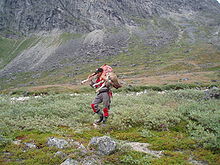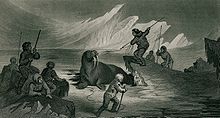- Culture of Greenland
-
The culture of Greenland has much in common with Inuit tradition, as the majority of people are descended from Inuit. Many people still go ice-fishing and there are annual dog-sled races in which everyone with a team participates.
However, Greenland has now become somewhat of a tourist attraction. It holds contests to attract tourists such as dog racing, ice fishing, hiking, and cross country racing.
Contents
Traditional Greenlandic culture
Greenlandic people are mostly of Inuit origin. The nation's culture reflects that. Hunting is iconic to their culture and most Greenlanders still hunt at least part-time to supplement their diet and provide skins for clothing and kayaks.
The Thule region
The northwest corner of Greenland is known as the Thule region. It is roughly the size of Germany, but inhabited by fewer than 1,000 people. The northern-most year-round communities on earth (Siorapaluk, Moriasaq and Qaanaaq) are in the Thule region. Siorapaluk, with approximately 80 residents, is just 730 nautical miles (1,360 km) from the North Pole.
Currently, though most families in the Thule region need at least one member in salaried employment in order to pay for electricity and other modern amenities, hunting remains a revered profession. Traditional foods like seal, walrus, narwhal and caribou, are consumed frequently. Hunters still wear hand-made polar bear skin garments, caribou anoraks and skin boots for warmth on winter hunting trips. Many of the men maintain world-class kayaking and harpoon-throwing skills
Inuit identity as hunters
Cultural status of the hunting experience
Hunting has always been an important aspect of the Greenland Inuit culture:
- "The Inuit culture is the most pure hunting culture in existence. Having adapted to the extreme living conditions in the High Arctic of the North American continent for at least four thousand years, Inuit are not even hunter-gatherers. Inuit are hunters, pure and simple." (Henriette Rasmussen, Minister in Greenland Home Rule Government)[1]
Even today hunting is important as stated by the Greenland Home Rule Government:
- "Hunting is the heart and soul of Greenlandic culture.... Hunting is also very important from a cultural perspective. In a society such as Greenland, which for centuries was based on subsistence hunting (until about fifty years ago), hunting is still of great cultural importance. Irrespective of the fact that most live like wage-earners in a modern industrial society, many Greenlanders' identity is still deeply rooted in the hunting."[2]
Reindeer hunting has a special status in the hearts of the populace. Shooting a muskox provides four times as much meat as a reindeer, but "Greenlanders would much rather have caribou or reindeer meat than musk ox meat," says Josefine Nymand.[3] "But the experience is just as important [as the meat]," points out Peter Nielsen, Head of Office at the Ministry of Environment and Nature. "It is simply the most wonderful part of the year. The trips in for the caribou hunt in the beautiful autumn weather have a great social and physical meaning for people's wellbeing. It has many functions."[3]
Inuit welfare and hunting culture
- See also: Reindeer hunting in Greenland
The long history of mutual dependence between humans and reindeer necessitates continuing efforts to safeguard their relationship and the welfare of both parties. Reindeer hunting – which is also commonplace in many other parts of the world – is considered so vital to the cultural heritage of certain groups that there is an attempt[4][5][6] being made to get it placed on UNESCO's World Heritage List.[7]
The identity of the Inuit is closely tied to their geography, history and their attitudes toward hunting – "For Inuit, ecology, hunting and culture are synonymous."[8] – and their identity as hunters is under attack. Those attacks are "... viewed in the Arctic as a direct assault on culture, identity as well as sustainable use,"[9] and Inuit are reacting:
- "... for the Inuit, animal rights campaigns are just the latest in a long litany of religious, industry, and government policies imposed by outsiders – policies which ignore Inuit values and realities, and threaten the survival of one of the world's last remaining aboriginal hunting cultures."[10]
Therefore the circumpolar peoples and their organizations are actively engaged in attempts to protect their welfare, identity, interests, and culture, including their hunting culture. The "Kuujjuaq Declaration"[11] addressed perceived attacks on their autonomy and rights, and recommended that the Inuit Circumpolar Council "undertake a comprehensive study on how best to address global forces, such as the 'animal rights' and other destructive movements that aim to destroy Inuit sustainable use of living resources, and to report back to the next General Assembly on its findings."[12] The International Arctic Science Committee shares these viewpoints and therefore one of its objectives is to study the "sustainable use of living resources of high value to Arctic residents."[13]
Controversy
As valued as it is, traditional hunting in Greenland is under tremendous stress. Pressure from environmental and conservation groups has led Greenland's Home Rule Government to set hunting limits for most species. In January 2006, a 150 animal limit was set for the most prized of all Greenlandic animals, the polar bear. Hunters in the region say it is hard to survive on the quotas that have been established.
This is especially true due to the dramatic drop in seal skin prices in the late 1980s. That drop occurred after environmental pressure led to a collapse of the seal skin market in the United States. Today, the price of the skins remains so low that most Thule hunters tan only enough skins for personal use; they no longer process them for sale. Moreover, when asked what the single greatest threat to the traditional culture is, Qaanaaq hunter Lars Jeremiassen quickly replied, "Greenpeace". That response, (documented in 2006 by the Arctic I.CC.E. Project: Indigenous Climate Change Ethnographies,[1]) reflects the devastating effect that environmentalist-led protests against sealing and seal products have had on the Inuit way of life, not just in Greenland, but throughout the Arctic.
The impact of climate change
Another pressure for Greenland's hunters is climate change. According to the Arctic Climate Impact Assessement, the largest study ever conducted on the effects of warming in the Arctic, winter temperatures above the 63rd parallel north have increased on average, by 2 to 5 Celsius over the past 50 years and could rise by yet another 10. That increase is having a dramatic effect on the wildlife, environment and culture of the high Arctic. In an interview for the Arctic I.CC.E. Project, Savissavik hunter Simon Eliason said hunters are spending more time in the fjords (rather than on the sea ice) because there is less sea ice on which to hunt seal, walrus and polar bear. He also said that hunters who net seals under the ice in winter must pull in those nets within hours after an animal is caught. Worms and parasites that the hunters have never seen before rapidly riddle and destroy the carcasses if they are left in the water very long. Eliassen says he believes the parasites have moved north with the warmer water.
In addition, Siorapaluk hunter Otto Sirmigaq notes that hunting time is about half what it used to be because sea ice forms one to two months later than it did when he was a boy and melts one to two months sooner.
Traditional skills at risk
Finally, traditional Thule culture is threatened by development and the growing cash-based economy. Even the smallest settlements in northwest Greenland have electricity today, albeit a small supply of electricity powered by diesel generators. Having electricity, as well as ammunition, hunting rifles and other store-bought products, means that at least one member of every family must be in salaried employment. In most cases, that member is a woman—a wife, daughter or mother. The jobs held by the women allow the men to continue to hunt full-time. But one consequence of this division of labor is that Thule women are losing their knowledge of traditional skills faster than the men. These skills include flensing, treating and sewing skins.
See also
- Demographics of Greenland
- Greenland
- Kalaallisut language of Greenland
- Music of Greenland
- Polar bear hunting
- Reindeer hunting in Greenland
Notes and references
- ^ Rasmussen H. Sustainable Greenland and Indigenous Ideals. Henriette Rasmussen, Minister of Culture, Education, Science and Church of the Government of Greenland.
- ^ Hunting in Greenland. - Greenland Home Rule Government
- ^ a b Caribou and muskoxen are meat and adventure. - The Danish-Greenlandic Environmental Cooperation
- ^ Reindeer hunting as world heritage: A ten thousand year-long heritage. - Reindeer hunting as world heritage
- ^ About the project. - Reindeer hunting as world heritage
- ^ Børge Brende to chair the World Heritage. - Reindeer hunting as world heritage
- ^ UNESCO's World Heritage List. - UNESCO
- ^ Wenzel G. "Animal Rights, Human Rights: Ecology, Economy and Ideology in the Canadian Arctic" (1991).
- ^ Alan Herscovici. Forgotten Story: The impact of "animal-rights" campaigns on the Inuit. - National Council for Science and the Environment
- ^ The Kuujjuaq Declaration. - Inuit Circumpolar Conference
- ^ Kuujjuaq Declaration: Proceedings of ICC's 9th General Assembly, 11 - 16 August 2002. Inuit Circumpolar Conference (Canada)
- ^ Objectives of International Arctic Science Committee. - ProClim: Forum for Climate and Global Change; Forum of the Swiss Academy of Sciences
External links
Categories:- Greenlandic culture
Wikimedia Foundation. 2010.



